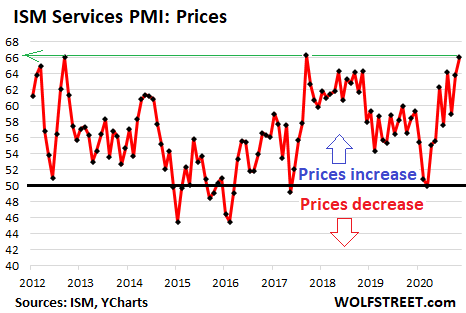Historically, 0 - 1% inflation has been the sweet spot correlating with the highest equity p/e ratios and as inflation rates move away from that range, both higher and lower, p/e's have tended to decline.
From Wolf Street, December 3:
Five reasons to “worry about faster inflation.” It’s “a greater danger precisely because it’s no longer perceived as such.”
“Given how completely financial markets have come to expect low inflation and interest rates, and how much support those expectations are providing to bond and stock prices, an upside surprise could prove nasty,” says former president of the Federal Reserve Bank of New York Bill Dudley, in a warning about how markets are ignoring the rising risks of inflation.
Companies have been raising prices, and they have been getting away with it. I’m not talking about prices at the gas station or grocery store which bounce up and down, but prices for things that are more stable, particularly services, where 70% of spending takes place, such as broadband services, shipping rates, and the regular highflyers, such as healthcare. Rents on a national basis are mix of plunging rents in some cities and surging rents in other cities. There has been inflation in goods too, including used-vehicle prices which have spiked by 15% since June,
Many of the restaurants that remained open raised their prices to deal with the additional costs and the decline in seating capacity during the Pandemic, and people are willing to pay those prices to support their restaurants. This happened across other industries that have cut capacity, triggering surging prices despite a decline in demand.
Some of these price increases happened because demand was red-hot, brought on by the sudden shifts to eating at home, working at home, learning at home, playing at home, and vacationing at home, and the other distortions brought about by the Weirdest Economy Ever. Other price increases happened because there were supply constraints due to the Pandemic, and the higher prices stuck.
Companies themselves are now reporting surging prices-paid in their part of the economy. This is particularly the case with services-oriented companies, where most of the economic action takes place. They’d only experienced a brief pause in price growth in March, and prices didn’t actually drop – they just stopped rising. But in April, prices took off. And for November, the ISM Services PMI for prices paid jumped to 66.1 (values above 50 indicate rising prices compared to the prior month, a higher value means prices rose faster). It was the eighth month in a row of price increases (above 50). And it matched the two sharpest month-to-month price increases since 2011.

These are prices paid – the costs of these companies are rising and are pressuring their margins, and they’ll want to pass those higher costs on to the next one in line.
But neither consumers nor markets see inflation. Least of all the Fed.In surveys, consumers remain calm about future inflation, though they face higher prices every day. Treasury market metrics of inflation are somnolent as well about the potential of future inflation. And Fed officials, in their Economic Projections, don’t see inflation (as measured by core PCE) reaching 2% until 2023....
....MUCH MORE